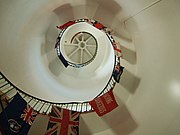Withernsea Lighthouse
 | |
 | |
| Location | Withernsea East Riding of Yorkshire England |
|---|---|
| OS grid | TA3393327967 |
| Coordinates | 53°43′51″N 0°01′44″E / 53.730953°N 0.028751°ECoordinates: 53°43′51″N 0°01′44″E / 53.730953°N 0.028751°E |
| Tower | |
| Constructed | 1894 |
| Construction | brick tower |
| Height | 128 feet (39 m) |
| Shape | tapered octagonal prism with balcony and lantern |
| Markings | white tower and lantern |
| Operator | Withernsea Lighthouse Museum [1] |
| Heritage | Grade II listed building[2] |
| Light | |
| Deactivated | 1976 |
Withernsea Lighthouse is an inland lighthouse that stands in the middle of the town of Withernsea in the East Riding of Yorkshire, England. The lighthouse stands 127 feet (38 m) high and took 18 months to build between 1892 and 1894.[3] Formerly owned and run by Trinity House of London, it ceased operation on 1 July 1976 and is now used as a museum.
History[]
The lighthouse is a surprising distance (nearly 1⁄4 mile or 400 metres) from the sea front. At the time it was built, there was nothing between it and the sea but sand dunes, and fear of coastal erosion led to it being positioned well back.[4]
Originally, the lantern contained an eight-wick paraffin lamp within a fixed Fresnel lens optic; it was an occulting light, the lamp being eclipsed three times in quick succession every minute.[5] The occulting mechanism was clockwork. A petroleum vapour lamp was introduced in the early 20th century;[6] the triple-occulting arrangement remained in place until 1936.[7]
In 1936 the light was electrified: it was given a 100 volt, 1500 watt bulb set within an eight-sided revolving third order Fresnel lens array, which displayed a white flash every three seconds with a range of 17 nmi (31 km; 20 mi).[3] Withernsea was the first lighthouse in the North of England to be converted from oil to electricity. It ran off mains electricity, but if the main lamp failed an automatic lamp changer brought a battery-powered lamp into action.[8] This arrangement, provided by the Chloride Electrical Storage Company, was said to be 'the first electrical emergency lighting system to be adopted by Trinity House for a lighthouse'.[9] A similar system was installed at Lowestoft two years later, and subsequently it was widely adopted across the service.
The lens weighed two tons and floated in a mercury bath; it was turned by clockwork. The lighting system, lens and clockwork mechanism remained in use into the 1970s.[10] Before decommissioning in 1976, the lighthouse was operated as a 'man-and-wife station', run by a couple who were accommodated in the adjacent cottage.[11]
Lighthouse today[]
The base of the lighthouse features RNLI and HM Coastguard exhibits, with models and old photographs. These record the history of ship-wrecks in the area and detail the Withernsea lifeboats and crews who saved 87 lives between 1862 and 1913. It also depicts the history of the nearby Spurn lifeboats.
The local history room has Victorian and Edwardian photos of the town including the pier and railway.
There is a Kay Kendall memorial to the 1950s film star, who was born in the town.
Views from the lamp room in the Withernsea Lighthouse are breathtaking, especially after climbing the 144 steps. There is no lamp, however, as this was removed after closure and sent to St Mary's Lighthouse in Tyne and Wear where it can still be seen to this day.[4]
The lighthouse and adjoining lighthouse keepers' houses are now a Grade II listed building.[2]
Gallery[]

As seen from the street

Garden view of the lighthouse and keepers' cottage

Steps inside the lighthouse

The view from the top

Trinity House plaque on the tower
See also[]
References[]
- ^ Rowlett, Russ. "Lighthouses of Eastern England". The Lighthouse Directory. University of North Carolina at Chapel Hill. Retrieved 27 April 2016.
- ^ a b Historic England. "Withernsea Lighthouse and adjoining pair of lighthouse keepers cottages (1083470)". National Heritage List for England. Retrieved 25 June 2014.
- ^ a b "About The Lighthouse". Withernsea Lighthouse Museum. Retrieved 11 September 2019.
- ^ a b Jones, Robin (2014). Lighthouses of the North East Coast. Wellington, Somerset: Halsgrove.
- ^ London Gazette, Issue 26487, Page 1091, 20 February 1894.
- ^ Miles, George T. J.; Richardson, William (1911). A History of Withernsea. Hull: A. Brown & Sons. p. 38.
- ^ Talbot-Booth, E. C. (1936). A Cruising Companion: Ships and the Sea. New York & London: D. Appleton-Century Company. p. 65.
- ^ "News in Brief: Electric Lighthouse". The Electrical Journal. 116: 99. 24 January 1936.
- ^ "News in Brief: Lighthouse Emergency Lighting". The Electrician. 116: 189. 7 February 1936.
- ^ "Withernsea (photographed in 1974)". Lighthouses of England. Retrieved 11 September 2019.
- ^ Jackson, Derrick (1975). Lighthouses of England and Wales. Newton Abbott, Devon: David & Charles. p. 105.
External links[]
| Wikimedia Commons has media related to Withernsea Lighthouse. |
- Lighthouses completed in 1894
- Lighthouses in the East Riding of Yorkshire
- Grade II listed buildings in the East Riding of Yorkshire
- Grade II listed lighthouses
- Holderness
- Withernsea
- Lighthouse museums in England
- Museums in the East Riding of Yorkshire





